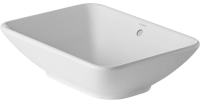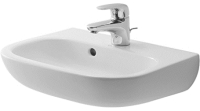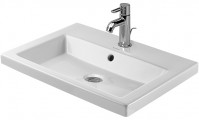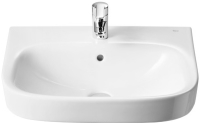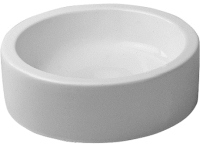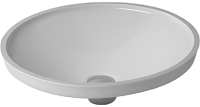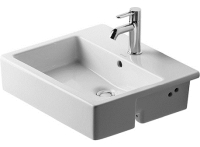Bathroom Sinks Duravit
All Bathroom Sinks Advanced filters → |
You might be interested in
Bathroom Sinks: specifications, types
Features
— For kids. By «kids» usually mean sinks designed for children of pre-school and primary school age. The most notable feature of such washbasins is the reduced size. For models with a pedestal this also applies to the overall height - otherwise, a small user could not normally get to the sink. In addition, some of them have bright, unusual design, interesting for children - although there are solutions in traditional strict design. In any case, washbasins from this category are mainly intended for kindergartens and junior classes of school, although such a product can be installed at home - if there is enough space in the bathroom.
— For people with disabilities. Such models are designed for those users who have difficulty standing on their feet - due to disability, disease, age etc. The most notable feature of washbasins for people with disabilities is the specific shape of the sink: its front side is concave «from the user», so the edges move forward. This is the most convenient shape in case you need to drive to the washbasin. Also protrusions give an additional support for the hands if the user wants to use the sink standing; however, if you need such a support - it is better to find a model where special handles are provided on the sides of the sink, these options are also found. It should also be noted that washbasins for people with disabilities are most often mounted hanging - partly so that the sink can be hung at an optimal height, partly so that, again,...it can be reached by a stroller. And fasteners often have a reinforced design - in case the user will need all the weight on the sink; however, this point is better to specify separately.
— For people with disabilities. Such models are designed for those users who have difficulty standing on their feet - due to disability, disease, age etc. The most notable feature of washbasins for people with disabilities is the specific shape of the sink: its front side is concave «from the user», so the edges move forward. This is the most convenient shape in case you need to drive to the washbasin. Also protrusions give an additional support for the hands if the user wants to use the sink standing; however, if you need such a support - it is better to find a model where special handles are provided on the sides of the sink, these options are also found. It should also be noted that washbasins for people with disabilities are most often mounted hanging - partly so that the sink can be hung at an optimal height, partly so that, again,...it can be reached by a stroller. And fasteners often have a reinforced design - in case the user will need all the weight on the sink; however, this point is better to specify separately.
Mount type
— Suspended. Washbasins designed to be fixed to the wall. These models take up a minimum of space, but are quite difficult to install, because they require the installation on the wall of the corresponding attachments. It is very difficult to install. In addition, in most hanging washbasins, drain pipes (and sometimes eyeliner) often remain visible, which is not very aesthetic. You have to either put up with this, or go to certain devices (for example, independently build a bedside table to cover the pipes). At the same time, there are varieties devoid of this defect. These models are equipped either with a half pedestal (cf. «Complete»), or a full pedestal for installation on the floor. However, in the latter case still require a wall mount for stability, and therefore they are not attributed to the following floor.
— Vessel on stand. Washbasins designed for installation on a specially adapted pedestal. Somewhat easier to install than hanging ones, as they do not require brackets or other attachments - it is enough to put the sink on the cabinet and bring communication. In addition, drain and other pipes during installation are hidden in the cabinet, which provides a neat appearance, and the cabinet itself can play the role of locker. On the other hand, the need to search and select the cabinets creates additional hassle, such washbasins take more space than the hangin...g, and features of the design somewhat limit the variety of forms.
— Vessel on tabletop. Type of overhead washbasins designed for installation on the countertop. In many ways similar to the overhead models designed for cabinets (see above), but much easier to install: in this case, no specialized pedestal is required, any horizontal surface with a hole under the drain is suitable. This makes it much easier to choose a stand for this type of washstand, and they can have almost any shape.
— Mortise in tabletop. Washbasins designed for integration into a flat surface. They look quite elegant and take up a little space, in addition leave the user with the option: the sink can be built into the top surface of a special cabinet, and in the simplest shelf. In the first case, you can hide inside the communication, and the second option provides maximum free space. At the same time, this type requires both a suitable surface (cabinet or shelf) and a hole in it in the shape of a shell - with a certain skill it is possible to make it yourself, but it is better to contact a specialist.
— Mortise under tabletop. A variety of mortise washbasins (see above), in which the upper edge of the sink during installation is located not above, but below the countertop. This moment does not play a special role (except that it is somewhat easier to clean up water spilled on the countertop — it is enough to “drive” it with a rag to the edge of the sink), in terms of its main features, this variety is completely similar to the previous one.
— On washing machine. Washbasins designed to be fitted with a washing machine under the sink. This option is convenient primarily because it allows you to optimally use the space in the room. At the same time, it should be borne in mind that modern «washers» can differ markedly in size, and before buying it will not hurt to clarify the compatibility of the washbasin with a particular machine; and if the machine has a vertical load, this option is not applicable at all. The nuances of the installation in different models of such washbasins may differ, but most often the sink is attached to the wall, and the washing machine is supported only partially (although the role of the main support is still played by the «washer»).
— Floor. In full accordance with the name of such washbasins are integral structures of bowls and cabinets designed for installation on the floor. Their main difference from the suspended models with a bedside table (see above) is that they are able to stand steadily on a flat floor without any additional attachments. Due to this, the floor model can be, metaphorically speaking, installed even in the middle of the bath (the main thing - to deal with the supply of pipes). Accordingly, this type is the easiest to install. However, the floor models are quite expensive.
There are washbasins designed for several installation options - for example, models with the possibility of applying both to the stand and to the table top.
— Vessel on stand. Washbasins designed for installation on a specially adapted pedestal. Somewhat easier to install than hanging ones, as they do not require brackets or other attachments - it is enough to put the sink on the cabinet and bring communication. In addition, drain and other pipes during installation are hidden in the cabinet, which provides a neat appearance, and the cabinet itself can play the role of locker. On the other hand, the need to search and select the cabinets creates additional hassle, such washbasins take more space than the hangin...g, and features of the design somewhat limit the variety of forms.
— Vessel on tabletop. Type of overhead washbasins designed for installation on the countertop. In many ways similar to the overhead models designed for cabinets (see above), but much easier to install: in this case, no specialized pedestal is required, any horizontal surface with a hole under the drain is suitable. This makes it much easier to choose a stand for this type of washstand, and they can have almost any shape.
— Mortise in tabletop. Washbasins designed for integration into a flat surface. They look quite elegant and take up a little space, in addition leave the user with the option: the sink can be built into the top surface of a special cabinet, and in the simplest shelf. In the first case, you can hide inside the communication, and the second option provides maximum free space. At the same time, this type requires both a suitable surface (cabinet or shelf) and a hole in it in the shape of a shell - with a certain skill it is possible to make it yourself, but it is better to contact a specialist.
— Mortise under tabletop. A variety of mortise washbasins (see above), in which the upper edge of the sink during installation is located not above, but below the countertop. This moment does not play a special role (except that it is somewhat easier to clean up water spilled on the countertop — it is enough to “drive” it with a rag to the edge of the sink), in terms of its main features, this variety is completely similar to the previous one.
— On washing machine. Washbasins designed to be fitted with a washing machine under the sink. This option is convenient primarily because it allows you to optimally use the space in the room. At the same time, it should be borne in mind that modern «washers» can differ markedly in size, and before buying it will not hurt to clarify the compatibility of the washbasin with a particular machine; and if the machine has a vertical load, this option is not applicable at all. The nuances of the installation in different models of such washbasins may differ, but most often the sink is attached to the wall, and the washing machine is supported only partially (although the role of the main support is still played by the «washer»).
— Floor. In full accordance with the name of such washbasins are integral structures of bowls and cabinets designed for installation on the floor. Their main difference from the suspended models with a bedside table (see above) is that they are able to stand steadily on a flat floor without any additional attachments. Due to this, the floor model can be, metaphorically speaking, installed even in the middle of the bath (the main thing - to deal with the supply of pipes). Accordingly, this type is the easiest to install. However, the floor models are quite expensive.
There are washbasins designed for several installation options - for example, models with the possibility of applying both to the stand and to the table top.
Washbasin material
The majority of washbasins are made of ceramic and engineered stone. However, there are also rare copper, acrylic, stainless steel, enameled steel and even glass. More about each of them:
— Ceramic composite. The most common material for modern sinks. Today ceramic washbasins are made of: porcelain and faience. Porcelain has good strength, but is difficult to manufacture, due to which it is quite expensive and relatively rare. Faience is a little less durable, at the same time it is cheaper and looks no worse, thanks to which it has become widespread.
— Artificial stone. Most often, this term means injection marble - a composite material based on marble or quartz crumb with a filler of polyester resin with dyes. The main advantage of engineered stone is durability: it is almost the most resistant material used in modern shells. In addition, it looks very good and easy to clean. However, such washbasins are quite expensive.
— Glass. Glass can be referred to as a premium materials: it looks elegant, at the same time very original, which makes it well suited to various interiors, incl. and non-standard. The main drawback of glass is its fragility: it is somewhat worse to withstand damage than the above materials, a...nd requires careful handling. This is especially true for heavy objects - they should not be dropped on glass shells.
— Stainless steel. The main advantage of steel is extremely high strength: such a washbasin can fly off the anchorages, but will not break and is not likely to even warp. In addition, this material has a specific, rather stylish appearance. On the other hand, steel washbasins are not cheap, and therefore are produced rarely - mainly in consideration of special conditions of use when strength and/or vandalism are important. For example, such models are good for public toilets in stadiums or concert complexes.
— Acrylic. Most often, acrylic is a composite material that combines acrylic itself (high-quality plastic) with fiberglass. One of the important advantages of such washbasins is ease of care: the acrylic surface resists stains and streaks well, is easy to clean, and old dirt does not form on it. However such a washbasin scratches relatively easily, but at the same time, scratches can be easily removed by grinding and polishing. But among the more serious drawbacks, poor compatibility with some detergents (mainly based on petroleum products) and sensitivity to high temperatures can be noted. The latter is especially true for bathrooms with boilers, where much hotter water can come from a tap than from a regular plumbing. However, this material tolerates short-term contact with "boiling water" without consequences.
— Natural stone. Expensive and prestigious material used in premium, mainly designer, washbasins. The natural stone has a solid appearance, is pleasant to the touch, is excellent against scratches and easy to clean. In addition, the environmental friendliness of this material can also be recorded. On the other hand, natural stone is very expensive, and heavy weight makes transportation and installation difficult.
— Enamelled steel. Steel, additionally coated with a layer of enamel. The steel base is strong and reliable, and the coating looks nice and provides increased scratch resistance. In addition, it can be given almost any shade, and the design of such washbasins is not limited to gray-steel color «stainless steel». The price of enameled products can be different, depending on the brand and overall quality of manufacture. From their shortcomings we can call sensitivity to impacts - from this on the enamel may appear chipping.
— Copper. Copper washbasins are primarily a designer series of plumbing equipment. Most copper washbasins are created in an antique style, with a layer of patina created on the surface of copper, which is easy to give the plumbing an ancient look. In total, copper is valued for its excellent antibacterial properties. It is not uncommon for a copper washbasin to require a table top, as copper plumbing is very heavy.
— Ceramic composite. The most common material for modern sinks. Today ceramic washbasins are made of: porcelain and faience. Porcelain has good strength, but is difficult to manufacture, due to which it is quite expensive and relatively rare. Faience is a little less durable, at the same time it is cheaper and looks no worse, thanks to which it has become widespread.
— Artificial stone. Most often, this term means injection marble - a composite material based on marble or quartz crumb with a filler of polyester resin with dyes. The main advantage of engineered stone is durability: it is almost the most resistant material used in modern shells. In addition, it looks very good and easy to clean. However, such washbasins are quite expensive.
— Glass. Glass can be referred to as a premium materials: it looks elegant, at the same time very original, which makes it well suited to various interiors, incl. and non-standard. The main drawback of glass is its fragility: it is somewhat worse to withstand damage than the above materials, a...nd requires careful handling. This is especially true for heavy objects - they should not be dropped on glass shells.
— Stainless steel. The main advantage of steel is extremely high strength: such a washbasin can fly off the anchorages, but will not break and is not likely to even warp. In addition, this material has a specific, rather stylish appearance. On the other hand, steel washbasins are not cheap, and therefore are produced rarely - mainly in consideration of special conditions of use when strength and/or vandalism are important. For example, such models are good for public toilets in stadiums or concert complexes.
— Acrylic. Most often, acrylic is a composite material that combines acrylic itself (high-quality plastic) with fiberglass. One of the important advantages of such washbasins is ease of care: the acrylic surface resists stains and streaks well, is easy to clean, and old dirt does not form on it. However such a washbasin scratches relatively easily, but at the same time, scratches can be easily removed by grinding and polishing. But among the more serious drawbacks, poor compatibility with some detergents (mainly based on petroleum products) and sensitivity to high temperatures can be noted. The latter is especially true for bathrooms with boilers, where much hotter water can come from a tap than from a regular plumbing. However, this material tolerates short-term contact with "boiling water" without consequences.
— Natural stone. Expensive and prestigious material used in premium, mainly designer, washbasins. The natural stone has a solid appearance, is pleasant to the touch, is excellent against scratches and easy to clean. In addition, the environmental friendliness of this material can also be recorded. On the other hand, natural stone is very expensive, and heavy weight makes transportation and installation difficult.
— Enamelled steel. Steel, additionally coated with a layer of enamel. The steel base is strong and reliable, and the coating looks nice and provides increased scratch resistance. In addition, it can be given almost any shade, and the design of such washbasins is not limited to gray-steel color «stainless steel». The price of enameled products can be different, depending on the brand and overall quality of manufacture. From their shortcomings we can call sensitivity to impacts - from this on the enamel may appear chipping.
— Copper. Copper washbasins are primarily a designer series of plumbing equipment. Most copper washbasins are created in an antique style, with a layer of patina created on the surface of copper, which is easy to give the plumbing an ancient look. In total, copper is valued for its excellent antibacterial properties. It is not uncommon for a copper washbasin to require a table top, as copper plumbing is very heavy.
Shape
The shape of the basin bowl. In most cases, the shape of the bowl does not affect the possibilities of the washbasin and is selected based on the installation features. For example, when mounting the table top (see above), the only limitation is the design of the bathroom and personal preferences of the buyer; when installing on the cabinet, you must also take into account the shape of the cabinet; hanging models inevitably have a flat back wall for wall mounting, etc.
In a separate variety can be distinguished corner washbasins: This shape is designed for small rooms where you have to save as much space as possible. If savings are not critical, it makes sense to look at other options.
In a separate variety can be distinguished corner washbasins: This shape is designed for small rooms where you have to save as much space as possible. If savings are not critical, it makes sense to look at other options.
Double washbasin
As the name suggests, double washbasin is intended for use by two people. To do this, it has a large width that allows you to place 2 personal cups or one large. But the key aspect is the possibility of installing two mixers at once - for each person.
Patterned
Presence on the sink decorative pattern. This feature does not affect the functionality, but models with the pattern have an unusual appearance and are noticeably stand out in comparison with ordinary washbasins without a pattern. This product can be especially useful for the original design.
Number of bowls
Number of individual bowls (sinks) provided in the design of the washbasin. Most models are produced with one bowl, this is enough for normal household use. However, there are variants with two bowls and more. They are designed for situations where the washbasin often has to use several people at once; such models can be useful, for example, in cafe bathrooms or in spacious apartments where there is space in the bathroom to install a steam sink.
Bowl location
Position of the bowl (sink) relative to the body of the washbasin.
— Centre. The most simple and optimal configuration, centered on the wide side of the shell. It is found in the vast majority of modern models of washbasins.
— Right. Positioning the bowl on the right will be by the way in non-standard conditions of installation of the washbasin. Such models are most often installed on corner cabinets, which are located in the left corner of the room. They can also be installed independently - under the wing of some washbasins with an offset bowl can be placed, for example, a washing machine.
— Left. Mirror version of the «right» bowl, placed on the left hand relative to the basin body. Plays practical value in non-standard conditions or acts as a design element of the bathroom.
— Left / right. In some washbasins, the manufacturer or store does not specify the exact placement of the bowl in the model name. The side of the sink must be specified at the stage of agreement with the seller of the goods, so that the purchase of a suitable washbasin was without surprises.
— Centre. The most simple and optimal configuration, centered on the wide side of the shell. It is found in the vast majority of modern models of washbasins.
— Right. Positioning the bowl on the right will be by the way in non-standard conditions of installation of the washbasin. Such models are most often installed on corner cabinets, which are located in the left corner of the room. They can also be installed independently - under the wing of some washbasins with an offset bowl can be placed, for example, a washing machine.
— Left. Mirror version of the «right» bowl, placed on the left hand relative to the basin body. Plays practical value in non-standard conditions or acts as a design element of the bathroom.
— Left / right. In some washbasins, the manufacturer or store does not specify the exact placement of the bowl in the model name. The side of the sink must be specified at the stage of agreement with the seller of the goods, so that the purchase of a suitable washbasin was without surprises.
Wing
The wing is a flat surface located usually on both sides of the shell at the level of its upper edge; the arrangement on one side implies the corresponding one-way arrangement of the bowl (see above). Such a surface can play the role of a kind of shelf: it can, for example, put appropriate accessories for shaving or cosmetics when wearing makeup.
Overflow
The overflow is a special opening located at the top of the shell. It prevents the transfusion of water over the edge: reaching the overflow, water through a special hose enters the drain pipe, which saves the bathroom from the «flood». Such a hose may be part of the wash basin, but most often it has to be purchased separately.
Note that overflow is designed for situations when the drain itself is closed (for example, by plugging); but if the drain is clogged lower (for example, in a siphon), this function will be useless - the water will still have nowhere to go from the filling shell. And therefore, the presence of overflow in the design of the wash basin does not eliminate the need to monitor the state of the sewer.
Note that overflow is designed for situations when the drain itself is closed (for example, by plugging); but if the drain is clogged lower (for example, in a siphon), this function will be useless - the water will still have nowhere to go from the filling shell. And therefore, the presence of overflow in the design of the wash basin does not eliminate the need to monitor the state of the sewer.
Antibacterial coating
Special hygienic coating in the washbasin. This coating prevents the reproduction of pathogenic bacteria and helps to maintain the cleanliness of the washbasin, reducing the likelihood of plaque and unpleasant odor. In addition, the smooth antibacterial surface also improves the appearance of the product.
Note that such products still have to be washed periodically; however, this has to be done less frequently than in the absence of antibacterial coating.
Note that such products still have to be washed periodically; however, this has to be done less frequently than in the absence of antibacterial coating.
Tap hole
The presence in the design of the wash-basin the opening for the installation of the mixer. This function is useful if you want to equip the washbasin with its own mixer: it is much easier to install it directly on the sink than to mount separately or to select a place for the sink under the already installed mixer. In such cases, a sink without opening for mixer.
When choosing a model with this function, you should pay attention to the number of holes. For a conventional mixer, one «footprint» is enough, but for embedded cranes, where the drain and controls are removed separately, and mounting holes will need the appropriate amount.
When choosing a model with this function, you should pay attention to the number of holes. For a conventional mixer, one «footprint» is enough, but for embedded cranes, where the drain and controls are removed separately, and mounting holes will need the appropriate amount.
Tap hole diameter
The diameter of the hole required for the installation of the mixer. This size makes it possible to understand the size of the mixer to be selected, the size of the additional parts to be fitted and whether the opening for an existing faucet has to be extended or narrowed.
In box
— Pedestal. Design element designed to install the washbasin on the floor; simply put - a stand. It is found in floor washbasins as well as in some hanging ones (cf. «Type of installation»). In addition to maintaining the sink, the pedestal plays an aesthetic role: it hides eyeliner and drain pipe inside itself, providing a neat appearance.
— Semi-pedestal. An element of the construction of the washbasin, designed to cover the drain pipe (and sometimes - and eyeliner). In this sense, it is similar to the pedestal (see above). However, unlike it, does not play the role of a stand, because it is not attached to the floor, but to the wall. It is found in suspended models (cf. «Mounting type»). The advantage of the half pedestal is the minimum occupied space - it does not reach the floor. At the same time, the installation of such washbasins is associated with certain difficulties, because it requires the appropriate location of communications in the house: in particular, the outlets of sewer pipes should be located in the wall at half pedestal level.
— Bottom valve. The presence of an automatic valve in the design of the wash basin. In fact, such a valve is an automated plug for the drain hole: with a special switch, you can close and open the drain at will. This is much more convenient than putting and removing the plug manually, in addition, it elimin...ates the need to buy it separately (but the plug still needs to pick up the size of the drain hole, the valve by definition does not require it).
— Siphon. Siphon is a curved drain pipe that is required to connect the sink to the sewer. The presence of such a pipe in the supply of the washbasin will save you the need to pick up and buy it separately.
— Towel holder. The towel carrier is a towel rack fixed directly to the washbasin, usually in the form of a straight or curved bar. This feature allows you to always keep the towel at hand, and also provides an additional place for it - it is useful in large families where many towels can be used at the same time.
— Semi-pedestal. An element of the construction of the washbasin, designed to cover the drain pipe (and sometimes - and eyeliner). In this sense, it is similar to the pedestal (see above). However, unlike it, does not play the role of a stand, because it is not attached to the floor, but to the wall. It is found in suspended models (cf. «Mounting type»). The advantage of the half pedestal is the minimum occupied space - it does not reach the floor. At the same time, the installation of such washbasins is associated with certain difficulties, because it requires the appropriate location of communications in the house: in particular, the outlets of sewer pipes should be located in the wall at half pedestal level.
— Bottom valve. The presence of an automatic valve in the design of the wash basin. In fact, such a valve is an automated plug for the drain hole: with a special switch, you can close and open the drain at will. This is much more convenient than putting and removing the plug manually, in addition, it elimin...ates the need to buy it separately (but the plug still needs to pick up the size of the drain hole, the valve by definition does not require it).
— Siphon. Siphon is a curved drain pipe that is required to connect the sink to the sewer. The presence of such a pipe in the supply of the washbasin will save you the need to pick up and buy it separately.
— Towel holder. The towel carrier is a towel rack fixed directly to the washbasin, usually in the form of a straight or curved bar. This feature allows you to always keep the towel at hand, and also provides an additional place for it - it is useful in large families where many towels can be used at the same time.
Country of origin
There are many national stereotypes: many users find certain countries more attractive than others. However, nowadays these stereotypes are practically unfounded. Firstly, in the country of origin of the brand, often only the headquarters of the manufacturer is located, and the production may be located in another state. Secondly, the origin of a certain country is not yet a guarantee of quality: it all depends on how carefully a particular manufacturer controls its products. Therefore, to assess the quality, it is worth focusing not on “nationality”, but first of all on the reputation of a particular brand and the price category of the product. Among the countries represented are the following: Belgium, Germany, India, Spain, Italy, Poland, Portugal, Slovenia, USA, Turkey, France, Czech Republic, Switzerland, Sweden, Japan.
Manufacturer's warranty
The warranty period declared by the manufacturer for this model - that is, the period during which the manufacturer guarantees normal operation. The specific terms of the warranty may vary, but as a rule it applies to factory defects and faults caused by the manufacturer/seller and detected in normal use, without violating the rules.
The longer the warranty period - the more reliable is the washbasin, the higher its overall quality, other things being equal, but the more expensive it will be compared to the analogues. And the guarantee can be measured even for decades - besides the basic 5 years and 10 years, there are models with 25-year warranty and even with lifetime.
The longer the warranty period - the more reliable is the washbasin, the higher its overall quality, other things being equal, but the more expensive it will be compared to the analogues. And the guarantee can be measured even for decades - besides the basic 5 years and 10 years, there are models with 25-year warranty and even with lifetime.

